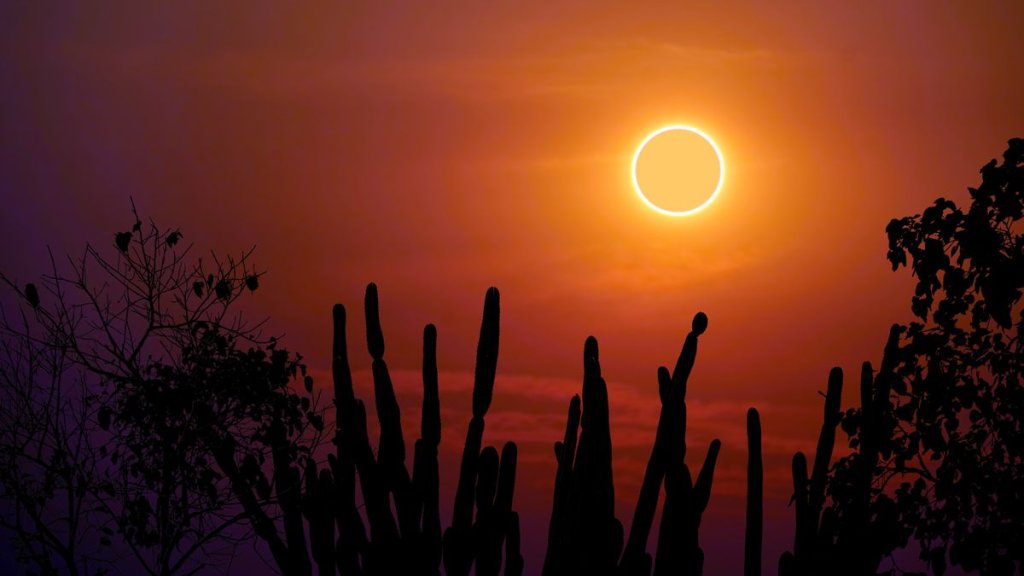An annular solar eclipse will be visible across North America on Saturday, Oct. 14, 2023.
The October annular eclipse‘s infamous “ring of fire” will cross eight U.S. states from Oregon to Texas, according to NASA. If you’re not fortunate enough to see it in person, the eclipse will be livestreamed for free so you can enjoy the wonder of the eclipse from the comfort of your own home.
During an annular solar eclipse, the moon appears slightly smaller than the sun. As such, it doesn’t block the entire solar disk like it would during a total solar eclipse. Instead, the moon’s shadow covers most of the disk, leaving the outer rim, resulting in a beautiful “ring of fire.”
Related: Which U.S. states will October’s ‘ring of fire’ solar eclipse be visible from?
Watching the eclipse in person
During the annular solar eclipse, the entire Americas will experience a partial solar eclipse. But for those of you who want to see the ‘ring of fire,’ you’ll need to travel to the 125-mile (200-kilometer) wide path heading from the northwest U.S. through Central America to Brazil.
For those wanting to venture to one of the eight states that will experience the ‘ring of fire,’ our guide on how to plan your annular solar eclipse trip may help. We also have guides on the 10 best events across the U.S. to celebrate the Oct. 14 eclipse as well as a roundup of five iconic routes through the U.S. for those wanting to take an eclipse roadtrip of a lifetime.
Below is a list of notable locations and cities that will experience the ‘ring of fire’ solar eclipse, along with the time and duration of the event according to French eclipse expert Xavier Jubier who has created an interactive map detailing the entire path of the annular solar eclipse.
- Oregon Dunes, Oregon: 9:15 a.m. PDT; 4 minutes, 29 seconds
- Crater Lake National Park, Oregon: 9:17 a.m. PDT; 4 minutes, 19 seconds
- Lava Beds National Monument, California: 9:19 a.m. PDT; 54 seconds
- Great Basin National Park, Nevada: 9:24 a.m. PDT; 3 minutes, 46 seconds
- Bryce Canyon National Park, Utah: 10:27 a.m. MDT; 2 minutes, 31 seconds
- Capitol Reef National Park, Utah: 10:27 a.m. MDT; 4 minutes, 37 seconds
- Canyonlands National Park, Utah: 10:29 a.m. MDT; 2 minutes, 24 seconds
- Natural Bridges National Monument, Utah: 10:29 a.m. MDT; 4 minutes, 29 seconds
- Monument Valley Navajo Tribal Park, Arizona: 10:29 a.m. MDT; 4 minutes, 16 seconds
- Mesa Verde National Park, Colorado: 10:31 a.m. MDT; 2 minutes, 57 seconds
- Chaco Culture National Park, New Mexico: 10:32 a.m. MDT; 4 minutes, 42 seconds
- Albuquerque, New Mexico: 10:34 a.m. MDT; 4 minutes, 42 seconds
- San Antonio: 11:52 a.m. CDT; 4 minutes, 5 seconds
- Corpus Christi, Texas: 11:55 a.m. CDT; 4 minutes, 52 seconds
- Padre Island National Seashore, Texas: 11:56 a.m. CDT; 4 minutes, 52 seconds
- Edzná Maya archaeological site, Yucatán Peninsula, Mexico: 11:23 a.m. CST; 4 minutes, 32 seconds
Watching the annular solar eclipse online — livestreams
For those of you wanting to watch the annular solar eclipse online, there are a number of livestreams available. You can watch the annular solar eclipse online here on Space.com or on one of the many YouTube channels broadcasting the event. We have rounded up some of the best livestreams available here.
NASA will broadcast telescope views of the annular solar eclipse from across the U.S. on their NASA YouTube channel. They’ll also be talking to solar scientists and are inviting the public to ask eclipse questions in the livestream chat using #askNASA.
Skywatching website timeanddate.com will also be covering the annular solar eclipse from start to finish with their livestream and live-blog with real-time progress reports and background information.
San Francisco’s Exploratorium will have several livestreams available, from the Valley of the Gods, Utah to Ely, Nevada. They will also include a stream with live sonification (music only without any other commentary or interruptions) and also live eclipse coverage in Spanish.
Follow us on Twitter @Spacedotcom and Facebook.

